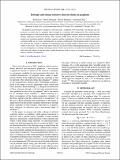Isotropic and energy-selective electron cloaks on graphene
Author(s)
Liao, Bolin; Zebarjadi, Mona; Esfarjani, Keivan; Chen, Gang
DownloadLiao-2013-Isotropic and energy-selective.pdf (772.8Kb)
PUBLISHER_POLICY
Publisher Policy
Article is made available in accordance with the publisher's policy and may be subject to US copyright law. Please refer to the publisher's site for terms of use.
Terms of use
Metadata
Show full item recordAbstract
We propose and investigate a design for “electron cloaks” comprised of two electrodes, one top gate and one back gate, on either side of a graphene sheet arranged in a concentric disk configuration. Dirac electrons with specific energies can flow through these electron cloaks with negligible scattering, while electrons with different energies experience significant scattering. The scattering widths of the electron cloaks are analyzed using the partial wave formalism applied to the Dirac equation, and the contributions of the first two partial waves to the scattering widths are set to zero simultaneously via a proper combination of the potentials on the two electrodes. We show that this strategy is sufficient for reducing the total scattering widths to below 0.01% of the physical widths of the cloaks. This new design differs from the well-known Klein tunneling phenomenon in that, in our case, the transparency is isotropic and energy selective. These characteristics, in tandem with tunable Fermi levels and/or the gate voltages on the electrodes, enable the electron cloaks to serve as core units in the designs of new sensors, switches, or transistors.
Date issued
2013-10Department
Massachusetts Institute of Technology. Department of Mechanical EngineeringJournal
Physical Review B
Publisher
American Physical Society
Citation
Liao, Bolin, Mona Zebarjadi, Keivan Esfarjani, and Gang Chen. “Isotropic and Energy-Selective Electron Cloaks on Graphene.” Phys. Rev. B 88, no. 15 (October 2013). © 2013 American Physical Society
Version: Final published version
ISSN
1098-0121
1550-235X